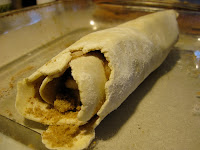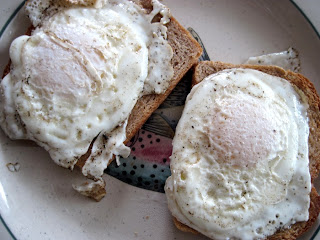
In The Mill on the Floss, Tom explains to Maggie why he will not be running away the next day. “It’s the pudden,” he confides, “I know what the pudden’s to be--apricot roll-up--oh my buttons!” I’ve never heard of a roll-up before except of course those strips of candied fruit puree that kids used to (do they still?) have in paper-bag lunches called “fruit roll-ups.” I assume this is a pastry. It sounds very appealing, but more appealing to a not especially wealthy nineteenth-century English family who only ever has such things on special occasions than to my contemporary palate. Apricot roll-up, ever since I read that sentence, has taken on a vibrant and uncertain life in my imagination. I keep thinking of the words nd of why Tom is oh-my-buttonsing about it. Incommensurate images float unresolved in my mind. How is it rolled up? It is made from fresh, dried, or otherwise preserved apricots? What kind of pastry dough are they rolled up in: pate brisee, pate sablee, puff pastry, yeasted dough, or something else? What is apricot roll-up? At this point a google search would not answer the question I’m trying to ask. I don’t want to know what it was historically, what George Eliot may have been referring to. Because I don’t know what it is I have begun to imagine something. I want to know what that something is, and in what ways it might be brought into the world.
Or maybe, considering what I did recently bake, I don’t want to make it tangible at all, and I’m content letting it draw me toward baked semblances. After making pear-ginger tarte tatin and sweet potato pie for Christmas, I still had some pie dough leftover in the fridge. Thinking of apricot roll-up, I rolled the remaining dough into a roughly rectangular sheet, covered it in thin pear slices, sprinkled it with brown sugar, cinnamon, and nutmeg, rolled it up and baked it at 400 F. Well, fifteen minutes in I became paranoid that it wouldn’t become properly crisp and turned it up to 425 F. Also I tried to pucker the ends together to keep the juices from running out too much. The juices did run out and burned to a black caramel at the bottom of the pan, but I liked it. It was a roll-up. The nice thing about a culinary fantasy defined by a single word with little semantic grounding is that it can be many things.
I was also pleased because this pear roll-up was made from things that just happened to be around. Probably derived from the frugality endorsed by environmentalism and an ego-aspiration to quiet resourcefulness, this is also one of my foremost culinary desires.
Like the sweet potato pie of last entry, I liked it because of what I thought I was making as well as because it, I thought, tasted good. Some vagueness or polyvalence in what I imagine I’m making seems to be a necessary part of this equation. Taste is again mediated by fantasy, but instead of the enticing photos I referred to as enthralling (as in actually placing me in their thrall) motivators to make Mrs. Hudson’s Biscuits, tarte tatin, and apple strudel, this came of a written phrase. Why do I romanticize the textual seed of this fantasy, and hold the photographic distastefully between thumb and pinky?
1 small round pate brisee
1 large pear
4 tablespoons brown sugar
1 1/2 teaspoons cinnamon
1/2 teaspoon nutmeg
Roll out pate brisee into a rectangle roughly twice as long as it is wide. Halve and core pear. Slice pear thinly. Lay pear slices parallel to the shorter edge in two rows. Sprinkle brown sugar, cinnamon, and nutmeg over pear slices. Roll from short side to short side. Pinch together the open ends of the roll. Place roll in a baking pan with the seam facing up. Bake at 425 F for about half an hour, or until the crust turns golden brown.




















































